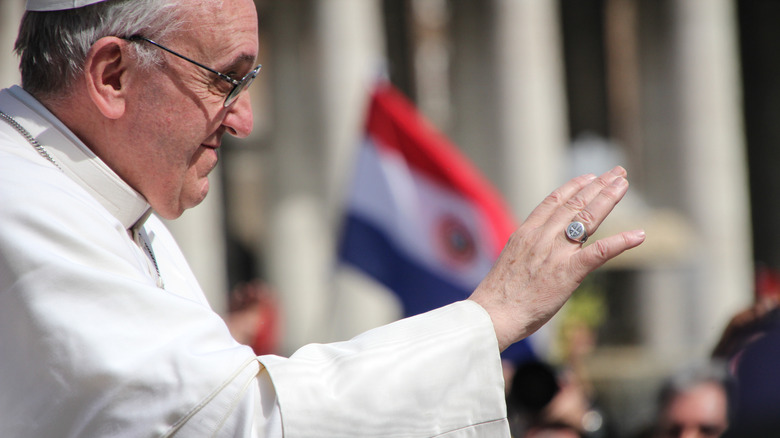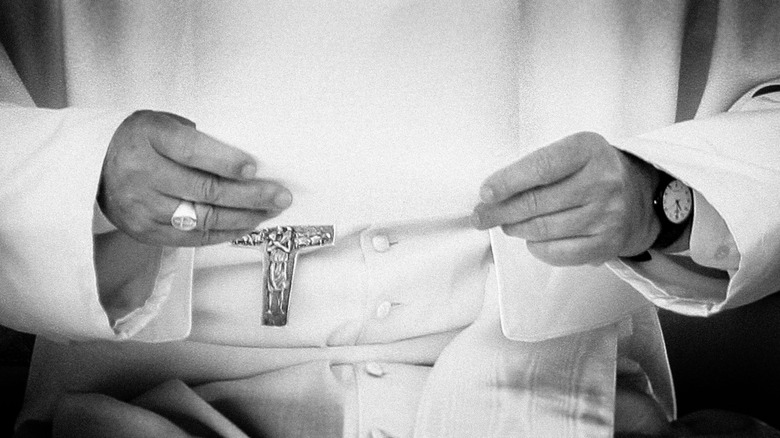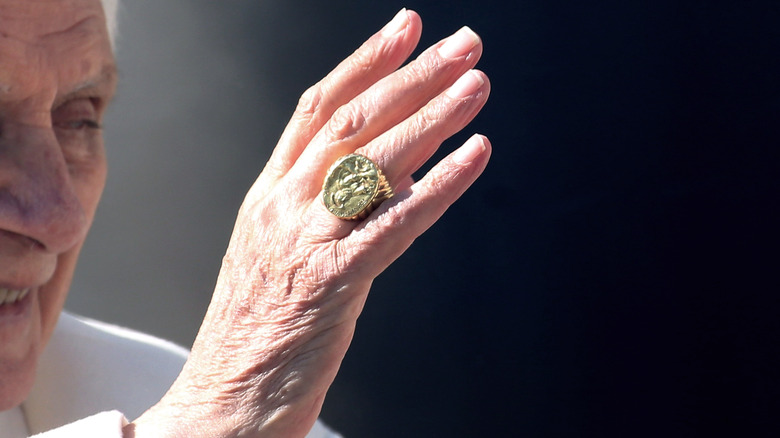How Much Is The Pope's Ring Worth?
Folks might have noticed that the pope is often decked out in bling. At least, the ones before Pope Francis. Francis tried his best to embody Christian humility, right down to living in a modest 538-square-foot apartment, refusing the papal salary of $32,000 per month, and stripping ornate rites from his funeral. His ethos extended to his traditional pope's ring, aka the Fisherman's Ring, as he opted for a simple, gold-plated silver design rather than a traditional golden model.
The pope's Fisherman's Ring is an ancient symbol connected to Christianity's roots and the Catholic Church's de facto first pope, Peter. The name references the New Testament Gospels, which all contain the same story about Jesus recruiting his initial disciples. As the Matthew 4 version reads, Jesus calls out to two brothers, Simon (called Peter) and Andrew, who are fishing in the Sea of Galilee, saying, "Come, follow me ... and I will send you out to fish for people." This is where the "fishers of men" phrase comes from, which ought to be familiar to Christians of all sects.
As for the cost of Pope Francis' ring, there are some unsubstantiated claims online placing its value at about $520,000, which is frankly impossible. Pope Benedict XVI's 35-gram, 24-karat gold ring was worth from $2,000 to $2,500, and Pope Francis' was gold-plated silver. Silver is currently worth about $1.06 per gram. A silver ring can weigh from 2 to 4 grams, and gold plating costs about $6.50. That likely puts the maximum total value of Francis' ring at around $10.75.
Pope Francis wore a simple silver ring
We don't know much about the origins of Pope Francis' gold-plated silver ring, but we know that it dates back to his tenure as cardinal in Argentina. He took the position back in 2001 during the reign of Pope John Paul II. New cardinals receive rings from the pope as part of the ritual that bestows them with the title. These rings, like the pope's Fisherman's Ring, symbolize the connection to St. Peter.
Beyond this basic fact, we've got no information about the ring aside from its simple, cross-shaped signet seen in pictures. Britannica also says that Francis' ring was gold-plated silver, although there's no gold visible in any of the pictures. As a Jesuit, this modest ring price fits Pope Francis' vow of poverty, which he would have taken when becoming a priest back in 1969.
But with or without gold-plating, which is very thin and inexpensive, Pope Francis' ring wouldn't have been worth much. According to Diply, the ring has an estimated worth of around $520,000, but it provides no source or data to back up this claim, which has been repeated by other outlets. Thankfully, a bit of online sleuthing reveals that silver rings are stunningly cheap — cheaper than a fast food hamburger. As mentioned, the market value of silver as of the time of writing is $1.06 per gram, and silver rings hover at 2 to 4 grams. And Francis' ring looked particularly thin and light.
Other papal rings throughout history
We stated that papal rings go back to St. Peter, who Jesus told in Matthew 16, "[O]n this rock I will build my church" — a famous quote amongst Christians. There's really no way to determine when popes started wearing Fisherman's Ring as an established tradition, but they're first mentioned in text — the "seal of the Fisherman" — in 1265 C.E. in a letter from Pope Clement IV to his nephew, Peter Grossi. By the 13th century, the rings' signets were pressed into wax to sign documents, a practice that died out by 1842. This is why the pope's ring gets destroyed with a hammer after they die — to prevent forgeries.
As for the cost of other pope's rings: Francis' immediate predecessor, Pope Benedict XVI, opted for a much more ornate Fisherman's Ring (seen above) that took eight craftsmen two weeks of 15-hour work days to craft. His 35-gram, 24-karat ring, inspired by a Michaelangelo painting, likely had a market value of $2,000 to $2,500, as cited earlier. Other rings throughout time all got destroyed, so they can't be appraised.
That being said, we do have ceremonial papal rings made from bronze that would have been used at certain events or given to couriers as evidence of a message's origin. But actual, pre-modern Fisherman's Rings would have been vastly more elaborate, made from gold, studded with gems, and meant to display wealth and power. As for how much these rings would have cost, we can only say "a lot."


